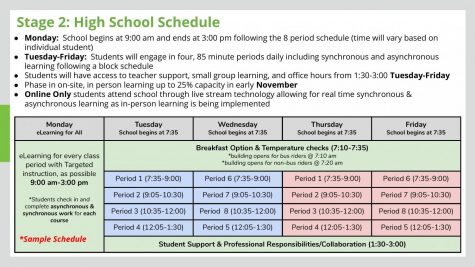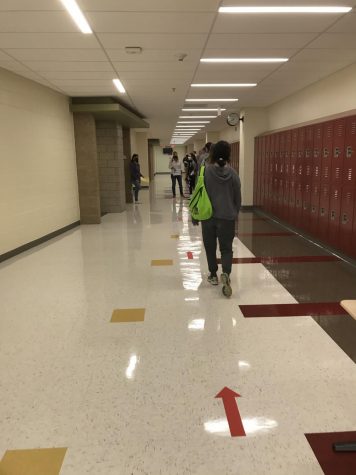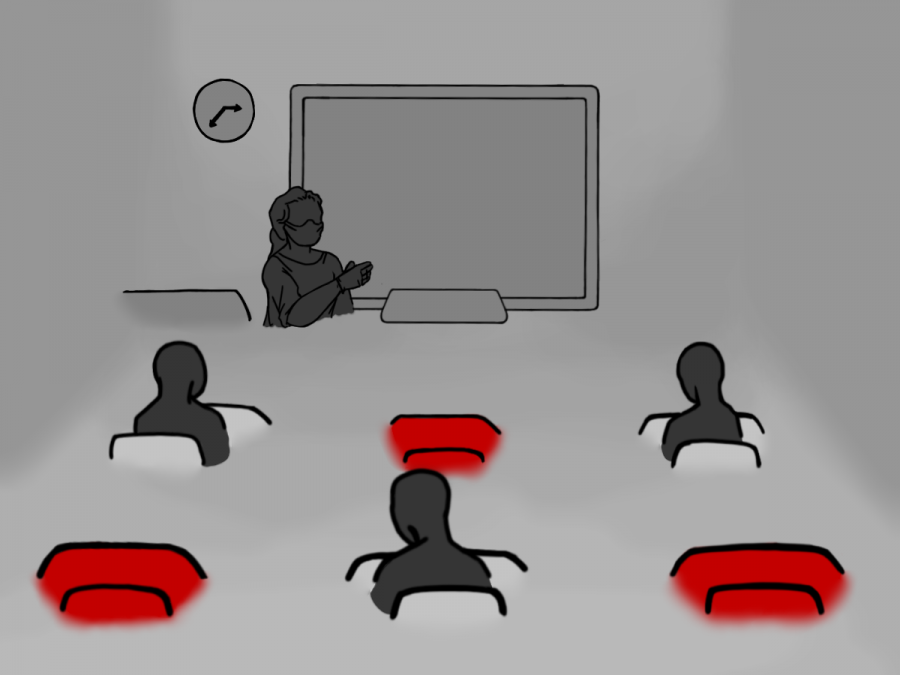Editorial: ‘Return to Learn’ Stage 2 brings positive changes, but looming Stage 3 looks like trouble
D203 plans to progressively bring more students throughout Stage 2 to achieve 50% capacity in Stage 3 learning, to start in late November.
October 18, 2020
On Monday, Oct. 5, District 203 released information regarding Stage 2 and 3 of our “Return to Learn” plan, which details how schools will transition back to in-person learning amidst the pandemic.
Stage 2, which will begin on Oct. 19, will continue e-learning, though teachers will be able to request for up to 10% of their students to come into the building. In early November, this threshold will be increased to 25% of students. High school students will switch to a block schedule. Mondays will be completely asynchronous with all eight periods, 50 minutes each, and school will go from 9 a.m. to 3 p.m. The rest of the week will include four 85 minute periods a day. Tuesdays and Thursdays will be periods one through four, while Wednesdays and Fridays will be periods five through eight. School on those days will go from 7:35 a.m to 1:30 p.m.

During Stage 3, which will begin in late November, up to 50% of students will be allowed to enter the building at a time. Following the block schedule, students will be split alphabetically and enter the building on alternating days. Teachers will livestream the in-person classes for students at home to follow along to. Students originally designated for the once proposed Online Academy will still be allowed to avoid entering the building at all.
The Central Times staff believes that the changes to e-learning in Stage 2 will be beneficial to high school students. Currently, having eight periods a day through Zoom is exhausting for us, and consequently each period is less productive than it could potentially be. By breaking each day up into fewer classes and more time for each class, students shouldn’t feel as overwhelmed each day and can dive into their material for each class more deeply. There are consequently fewer transition periods between classes, so teachers won’t have to deal with the inefficiencies of starting up so many Zoom calls and getting students situated. Allowing certain students to enter the building for lab work or additional assistance also seems reasonable. With the proper safety precautions, this can be done with a low risk of exposure for teachers or students.
Still, we have questions. How will the 85-minute periods be divided into synchronous and asynchronous time? Will transportation be arranged for students who have been asked to come in for a class? Can a student refuse to come in due to health concerns?
As a whole, Stage 3 feels more ambiguous, leaving us feeling uncomfortable with this portion of the plan, which will be here before we know it. It remains unclear to our staff how all of us going into the building on two-day rotations consistently benefits us or our teachers. Instead of teachers being able to give all of their attention to every student through Zoom, they will now have to split their time between those in their classroom and those watching from home via a livestream. Those choosing to remain home have been provided with no information about how this will work, much less a guarantee of the same quality of learning.
In terms of safety precautions, the district seems to be relying heavily on students feeling a sense of individual responsibility: wearing masks the whole day, social distancing in the halls and self-reporting symptoms, not to mention their adherence to these practices outside of school. The truth is, not all of us will feel this sense of duty, and it feels like too great of a risk for the collective safety of students. The logistics described in this portion of the district’s plan remains fairly inadequate and continues to spark even more questions when one reads it than it does provide answers.
We were left wondering, too, about double-block classes like American Studies, which will now be 170 minutes long, and whether or not there will be time for students to eat or drink during the seven-hour marathons that the schedule will require of every student at least once a week. Furthermore, we’re skeptical that our building’s campus supervisor staff has been increased to one large enough to have the manpower to enforce social distancing in the hallways and to monitor all bathrooms for entire periods. We’re also curious as to how often bathrooms will be cleaned, as toilets, soap and paper towel dispensers create high risk of exposure.

We’d be willing to bet that every one of us has attended school before on a day when we were sick and should have stayed home. What’s to stop us from continuing to do so? Can’t we lie about our symptoms, or the results of a COVID test? Are we to trust self-reporting? And how do we even know how prevalent the virus is in our school when the district is not forthcoming with numbers and really only has access to cases that are voluntarily reported to them?
Perhaps the million-dollar question is: How long will this last before we close back down again? What are the metrics and conditions that would force this to occur? And could students who choose the hybrid model switch to at-home learning if they lose confidence in their sense of safety at school as numbers in the state rise while we plow ahead?
Overall, Stage 2 looks very promising, but Stage 3 seems bound for failure. District 203 now seems focused on trying to please everyone in the wake of several recent rallies and while they continue to address what must surely be a tsunami of email messages demanding one thing or another. Unfortunately, Stage 3 will neither satisfy the “at school” nor the “at home” factions.
If neither e-learning nor in-person learning can be implemented to their fullest potential, what’s the point of this plan?








